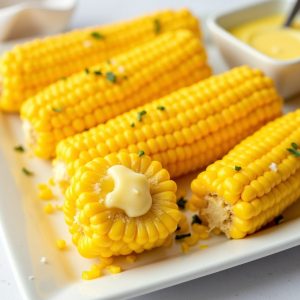
AI generated image
Chef's Tip
For the sweetest, most tender corn, cook it as soon as possible after purchasing. Corn's natural sugars begin converting to starch immediately after harvest, so freshness is key. When buying corn, look for bright green husks that are tightly wrapped and slightly damp with silk that is pale and moist.
Instructions
- Fill a large pot three-quarters full with water. Add kosher salt and sugar (if using).
- Bring water to a rolling boil over high heat.
- Gently add corn ears to the boiling water, making sure they're fully submerged.
- Cover pot and return to a boil. Once boiling, reduce heat to medium-high.
- Cook for 4-6 minutes for just-picked corn, or 6-8 minutes for corn that's a few days old. The kernels should be tender but still have a slight crunch.
- Using tongs, carefully remove corn from the water and place on a serving platter.
- Spread softened butter over each ear of corn while still hot, turning to coat all sides.
- Sprinkle with sea salt and freshly ground black pepper to taste.
- If desired, sprinkle with chopped fresh herbs for added flavor and color.
Plating
Arrange buttered corn on a large serving platter or individual plates. For a traditional presentation, insert decorative corn holders into each end of the cobs. Serve immediately while hot with additional butter on the side. For a summer gathering, place the platter of corn alongside other seasonal dishes on a buffet table.
Storage & Reheating
Corn on the cob is best enjoyed immediately after cooking. If necessary, leftover cooked corn can be refrigerated for up to 2 days. To reheat, wrap corn in damp paper towels and microwave in 20-second intervals until warmed through, or place in a 350°F oven for 5-10 minutes. Leftover corn kernels can be cut from the cob and used in salads, salsas, or soups.
About This Recipe
Corn on the cob has been a New England summer staple since Native Americans first introduced colonists to this versatile crop. This preparation honors the traditional simplicity of the dish, letting the natural sweetness of fresh corn take center stage. While variations with herb butters or spice blends have become popular, this classic version with just butter and salt represents the purist approach favored in traditional New England cookery.
